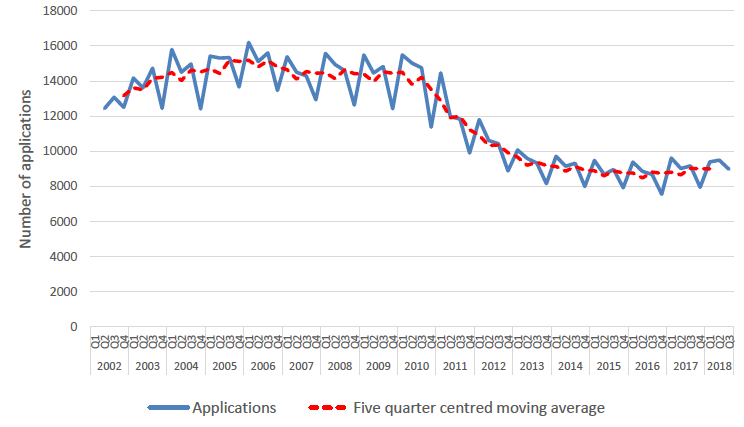Homelessness in Scotland: update to 30 September 2018
Information on homelessness applications, assessments and outcomes in the period to 30 September 2018.
This document is part of a collection
Applications
(Table 1 to Table 4 and Chart 1)
All applications
In the 6 months between 1 April and 30 September 2018, local authorities received 18,486 homelessness applications, an increase of 284 (2%) over the same period in the previous year (see Table 1). Looking over the whole of the last 12 months, there has been a smaller 1.3% (460 applications) annual increase from 35,378 applications in the 12 months to end September 2017 to 35,838 applications in the 12 months to end September 2018 (Table 1).
Chart 1 shows that the number of homelessness applications over time has decreased beginning around Spring 2010. This downward trend has slowed down over the last couple of years and has leveled out since 2015. There are quarterly fluctuations, but this trend is clearer when looking at the five-quarter centred moving average.
Chart 1: Number of applications for homelessness assistance in Scotland, by quarter, April 2002 to September 2018

Over the past few years, local authorities have been developing services in which staff assist households to consider the range of options available to address their housing needs - Housing Options[3]. As a consequence, some of the households who might previously have made a homelessness application may now have their housing needs met without first becoming homeless or being threatened with homelessness. This is likely to have contributed to an overall downward trend in the number of homelessness applications since 2010.[4] The more recent leveling out of homelessness applications (since 2015) suggests that the effect of Housing Options on decreasing homelessness application numbers may have reached a plateau.
For April to September 2018, almost 9,900 homelessness applications (53%) had been through a Housing Options service prior to making a homelessness application. During the same period in 2017, 57% of homelessness applications had been through Housing Options first (Table 1). This decreasing trend is also evident when looking at annual change. In the 12 months to end September 2018, we see again that 53% of applications had been through a Housing Options service first, compared to 57% during the same period in 2017.
When comparing the 12 months to end September 2018 with the previous 12 months to end September 2017, there has been a 1.3% increase in the number of homelessness applications to local authorities; however trends over time have varied between local authorities. Table 2 shows that when comparing these two time periods, the number of homelessness applications fell in 16 (50%) local authority areas and increased in the remaining 16 (50% of) local authority areas. The largest numerical reductions were in South Lanarkshire (-226 applications, -11%) and Glasgow (-190 applications, -3%). The largest increases were in North Lanarkshire (452 applications, 23%) and East Ayrshire (237 applications, 44%).
Reasons for homelessness
The underlying reasons for homelessness have remained very stable over time in Scotland, since April 2007. Table 3a and Table 3b show this since July 2016.
Of the 18,486 homelessness applications received in the 6 months period between April and September 2018:
- The most common reason cited was “asked to leave” – which accounted for a total of 4,472 (24%) applications, a decrease of 152 applications (3%) relative to the equivalent period of the previous year;
- The second most common reason cited was “non-violent dispute within the household and/or a relationship breakdown” – which accounted for a total of 3,316 (18%) applications, an increase of 120 (4%) compared to the same period in the previous year.
Table 4a shows that, in the 6 months between 1 April and 30 September 2018, there were 12,306 (67% of the 18,486) homelessness applications where the local authority recorded a reason for failing to maintain the accommodation[5]. Applicants are given a list of possible reasons, and local authorities may select multiple reasons. A greater proportion of applications had a reason for failing to maintain accommodation between April and September 2018 (67%) compared to the same period in 2017 (65%).
Of the 12,306 applicants with reasons for failing to maintain accommodation:
- 5,364 (44% of those completing this question) cited that it was not to do with the applicant’s household, but a result of external circumstances (e.g. due to landlord selling property, fire, circumstances of other persons sharing previous property or harassment by others). This figure has increased by 330 (7%) from the same period in the previous year;
- 2,995 (24% of those completing this question) applicants cited mental health reasons and 1,184 (10%) applicants cited physical health reasons. Since the same period in the previous year, the number of applicants citing mental health as a possible reason has increased by 376 applicants (14%). The number of times physical health was cited by applicants has increased by 136 (13%).
- 2,783 (23% of those completing this question) applicants cited lack of support from friends / family as a reason. This is an increase of 246 applications (10%) over the same period in the previous year; and
- 2,243 (18% of those completing this question) cited financial difficulties / debt / unemployment as a reason. This is an increase of 122 applicants (6%) compared to the same period in the previous year; and
- 713 (6% of those completing this question) cited an unmet need for support from housing / social work / health services. This is a notable increase of 272 (62%) compared to the same period in the previous year.
Contact
Email: Lee Bunce
There is a problem
Thanks for your feedback